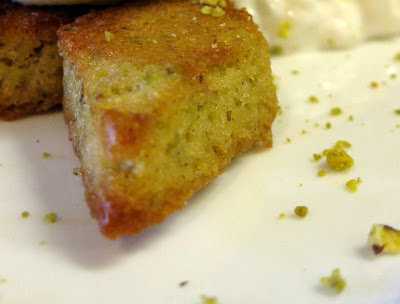
It’s amazing to me that pistachios aren’t a bigger part of the American identity. We produce a lot of them. As of 2005, we were a close second to Iran in production, the majority of which comes from California. The nut, which is actually a drupe, originated in the Middle East, and was introduces to the United States in 1904. It thrives in airid climates, making places such as Iran, the Mediterranean, and southwest US ideal places for pistachios to grow.
Pistachios have a wonderful fruity flavor that is very well suited to sweet applications. While in the US they are generally bought, shell-on and roasted, for consumption as a snack food, there are occasionally places that sell them raw. If you can’t find them in a local store, there are plenty of internet sources that sell them.
Financiers (pronounced Fee-Nan-See-Ay) are another of those French confections that have fallen by the wayside of modern pastry. They are little cakes, generally made with almond flour, egg whites, sugar, and my favorite ingredient of all time: brown butter. Traditionally, they would be baked in little rectangular molds that would make them look like little gold ingots, hence the name financier. The cakes that ensue are enigmatic: light but chewy, airy but moist. Like the macaron, they are something that one can easily get hooked on.
As I said, financiers are traditionally made with almonds, but I don’t see any reason why one couldn’t use another nut in their place. A quick search through Google, and I found that I’m not alone. The only snafu I had was that I needed to make my own pistachio flour. In the end, it may be something that is worth buying pre-ground. In order to get the pistachios ground finely enough, I put them in a food processor to get them roughly ground, and then spread them out on a baking sheet in a LOW oven to dehydrate them for about 6 hours. I then put them in the freezer to get them rock hard before finally mixing them with 50% of the weight of sugar and putting them to the food processor one more time… As I said, it may be worth the investment to just buy the flour pre-ground. In terms of molds, you can certainly find financier molds, but its not strictly necessary. I used a flexipan with diamond shaped cavities, and was happy with the result. Also, mini muffin pans would work well.
| Pistachio Financier adapted from Stephane Glacier M.O.F | Yield~ 30 cakes |
| 250g Butter 300g Powdered Sugar 150g Pistachio Flour* 260g Egg whites 100g Flour 25g Honey *If you are making your own, subtract the sugar added during grinding from the total sugar amount | 1) Place butter in a small sauce pot over medium heat and brown until golden and nutty-smelling. 2) Add the honey to butter mixture and allow to cool 3) Sift together dry ingredients 4) Whip egg whites to soft peaks 5) Fold in the dry ingredients, followed by the browned butter 6) Place in piping bag and pipe into molds that have been sprayed with baking spray. 7) Bake at 400° for 12-15 minutes, rotating one in between |
 What would go with pistachio financiers? Well, anything. In fact, it was only sheer willpower that kept me from eating the entire batch. Of course, they would be delicious with a cup of tea, such as Earl Grey, or English Breakfast. They also would be good dipped in chocolate or served with preserves. For me, I used them to sop up the remnants of a tasty coconut rice pudding with a scoop of banana-pineapple sorbet.
What would go with pistachio financiers? Well, anything. In fact, it was only sheer willpower that kept me from eating the entire batch. Of course, they would be delicious with a cup of tea, such as Earl Grey, or English Breakfast. They also would be good dipped in chocolate or served with preserves. For me, I used them to sop up the remnants of a tasty coconut rice pudding with a scoop of banana-pineapple sorbet.


You will have to tell me when Jianken is offering this again. This sounds delicious!
ReplyDelete